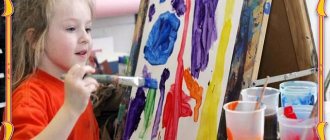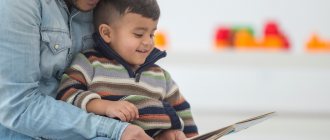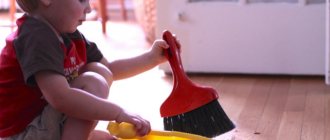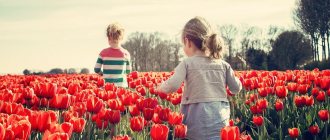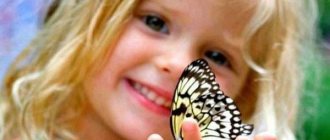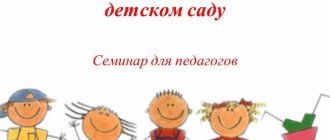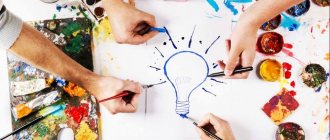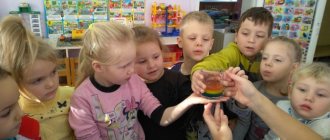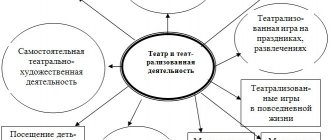Means and methods of aesthetic education of children in kindergarten
Korotkova Svetlana
Means and methods of aesthetic education of children in kindergarten
Means and methods of aesthetic education of children in kindergarten.
The basis of the process of aesthetic education is the joint activity of the teacher and the child, aimed at developing his abilities to perceive beauty , artistic values and productive activity. General issues of aesthetic education of children include : an organized environment in which a child grows up and is brought up , the use of works of art (reproductions of paintings, prints, sculptures, etc.) in the design of the premises of a preschool institution, involving children in artistic activities, taking into account the interests and inclinations of children .
The means of aesthetic education of children objects and phenomena of the surrounding reality selected by the teacher and specially organized for the upbringing of children
1. Aesthetics of everyday life.
It is designed to teach a child to feel and understand the beauty of life, to cultivate in him the desire to create and preserve it. The artistic design of a preschool institution is determined by the content of educational work , the requirements for protecting life and promoting health, and its artistic development. Cleanliness and order are not only hygienic, but also aesthetic requirements for the interior of a kindergarten . It is important that the design be stylistically consistent. by children , parents, and teachers to decorate the premises . the kindergarten playground must also meet the appropriate hygienic and aesthetic .
2. Works of art.
They are used in the design of everyday life, during training, and independent activities. For this purpose, works of everyday and fairy-tale painting are selected (portraits, still lifes, landscapes, graphics (prints, engravings, book illustrations, small forms of sculpture (products made of earthenware, plaster, wood, works of decorative and applied art (ceramics, art glass, folk decorative and etc.)
.
Various activities in kindergarten are necessarily accompanied by music (morning exercises, leisure activities, etc.)
.
3. Nature.
Growing up among nature , a child learns to see the harmony, beauty, richness of colors of each season, to reproduce his impressions in oral stories, drawings, etc. All this is accompanied by the teacher’s stories that nature is a powerful and perfect creator of beauty, painters draw inspiration from it , composers, writers, the use of their works (for example, “Seasons”
P. Tchaikovsky, reproductions of paintings by I. Shishkin, etc.).
Excursions to nature are effective, because the impressions a child experiences in preschool leave an imprint for life. It is important for the teacher to choose words to accompany observation that would meet the objectives of aesthetic education .
4. Special training.
The formation of ideas about beauty, skills in artistic and creative activity, the development of aesthetic assessments , experiences and tastes is facilitated by special training for preschoolers in kindergarten . To do this, they use various types of activities, artistic and didactic games, holidays, matinees, excursions, walks, watching movies and TV shows, performances, etc.
5. Independent artistic activity of children .
It is an important means of aesthetic education for preschool children . In the process of artistic activity, they realize their creative ideas, inclinations, which can subsequently develop into the ability for artistic creativity.
The development of independent artistic activity is stimulated by the following factors:
— the learning process in the classroom, its developmental nature, the formation of methods of independent action;
- artistic impressions of children , encouraging them to further implement them in activities;
- pedagogically appropriate aesthetic subject environment ;
- the encouraging influence of parents who stimulate the creative searches and attempts of children ;
- indirect influence of the teacher who initiates the independent search of children .
To develop independent artistic activity in the group, special zones (centers)
with the necessary equipment and materials that children can freely use.
At the same time, the teacher takes care of the variety of children’s , the combination of various types of artistic activities: visual, artistic and speech, theatrical and playful, musical.
6. Holidays.
They are associated with children's vivid aesthetic experiences and the desire to test themselves in different genres of art. Preparation for the holiday, the participation of children in the creation of its program, the conditions for holding it, and the anticipation of the festive action form a special pre-holiday collective mood. of children are often involved in the preparation and celebration , which gives them emotional warmth.
Interesting plans of a teacher for organizing the aesthetic education of preschoolers can achieve their goals by correctly selecting and combining his methods , which are classified according to various criteria:
- according to the main pedagogical goal.
These methods include : persuasion; exercises in practical actions aimed at transforming the environment ; problematic situations that encourage creative and practical action; incentives for empathy, an emotionally positive response to the beautiful, a negative attitude towards the ugly;
- in general and special areas.
This group includes general pedagogical and special methods , the selection of which depends on the type of art that the teacher seeks to introduce children ;
— methods of teaching artistic activity.
Among them are visual (sample, demonstration of techniques for performing actions, verbal (conversations, instructions, instructions, advice, assessment and self-assessment of the results of children’s );
— methods children’s artistic and creative abilities .
They are based on developing in children the ability to act when solving problem-search tasks in non-standard situations.
Researchers suggest using game-based teaching techniques, game situations, and acting out children’s works in the classroom the aesthetic education , which creates a positive emotional atmosphere, promotes effective mastery of fine arts and abilities, improves the quality of work and promotes the development of interest in fine arts. It is especially important to ensure a combination of various types of activities in the development of artistic skills of preschoolers.
Since in preschool age a child is primarily inclined to play, it is necessary to widely use a variety of gaming techniques in order to develop his creativity:
- game situations that help develop cognitive and creative activity;
- songs, riddles, poems, fairy tales, musical works;
- demonstration of episodes of puppet performances that focus attention , evoke positive emotions, interest in what is being depicted, deepen aesthetic pleasure , but do not affect the results of the work;
- stories - drawing with fairy tale elements; search situations; imaginary situations.
Children who have identified certain skills and interests in artistic and visual activities form a contingent of preschool institutions of artistic and aesthetic direction , in which, under the guidance of teachers with an artistic education, clubs, studios, and creative workshops function. Children are invited to participate in them , according to their inclinations and interests. Artistic activity creates serious opportunities for the manifestation of a child’s individuality, therefore, his knowledge and the development of artistic abilities are the primary condition for the child to understand himself as a person endowed with creative potential, to cultivate responsibility for his talent, as a gift from God, to strive, overcoming tough tests, to uniquely realize his talent. The history of world culture knows many examples when a child began to realize all this at an early age. Therefore, every teacher should proceed from the fact that, perhaps, his students harbor such dreams.
Aesthetic development is associated with the formation of all facets of personality. In preschool age, the foundations of needs and tastes are formed, a love of art is born, and creative abilities, which every child is endowed with to varying degrees, manifest themselves. To implement them, it is necessary to have properly organized education and training , which takes into account the characteristics of the age and individuality of the child.
MAGAZINE Preschooler.RF
Integrated use of various means and methods of aesthetic education in the system of preschool educational organizationMigaleva Marina Vladimirovna, teacher of MBDOU DS No. 72 “Watercolor”, Stary Oskol, Belgorod region
The concept of aesthetic education is organically connected with the term aesthetics. Aesthetics (from the Greek aisthetiris - sentient, related to sensory perception) is the science of the most general laws of aesthetic, including artistic, human mastery of reality [11].
The history of aesthetics begins with Ancient Greece. In ancient Greek philosophers we find many interesting opinions about beauty and art. One of the first to try to define beauty was Pythagoras. In his judgments about aesthetics, he remained a mathematician and tried to calculate and measure beauty. Heraclitus sees harmony at the basis of beauty, but believes that beauty cannot be reduced to the base laws of numerical relations, as was the case with Pythagoras. Other researchers consider either character or social reality to be the main factor in aesthetic education.
Let's consider the concept of aesthetic education in the works of teachers
Author Definition
Aristotle Beauty is the property of objects, things, and phenomena themselves. He considers integrity, unity, proportionality, and correspondence of form and content mandatory for works of art.
- L. S. Vygotsky Aesthetic education depends on the specifics of age development and is completely determined by it.
- Yu. K. Babansky Aesthetic education is a process of joint activity of teachers and students, aimed at developing the aesthetic culture of preschoolers.
- V. N. Shatskaya Aesthetic education is the purposeful formation in a person of his aesthetic attitude to reality.
- A. Ilyinov Aesthetic education is the process of purposefully developing in a person the ability to understand and appreciate the beautiful and comic, to feel and experience the tragic, to create beauty in all spheres of life.
Author's opinion Aesthetic education is one of the areas of pedagogy, the main goal of which is to teach a person to understand and appreciate beauty.
There are many definitions of the concept of “aesthetic education”, but having considered only a few of them, it is already possible to identify the main provisions that speak about its essence.
Firstly, this is a process of targeted influence. Secondly, it is the formation of the ability to perceive and see beauty in art and life, and appreciate it. Thirdly, the task of aesthetic education is the formation of aesthetic tastes and ideals of the individual. Fourthly, the development of the ability for independent creativity and creation of beauty.
A variety of creative activities for children contribute to the development of their thinking and imagination, will, perseverance, organization, and discipline. The goal of aesthetic education was most successfully reflected by M. M. Rukavitsyn, who believes: “The ultimate goal (of aesthetic education) is a harmonious personality, a comprehensively developed person... educated, progressive, highly moral, with the ability to work, the desire to create, who understands the beauty of life and the beauty of art.” [18; 142 pp.]
Thus, having studied the many definitions of “aesthetic education”, one cannot but agree with the words of the Russian playwright A.P. Chekhov: “Everything in a person should be beautiful: face, clothes, soul, and thoughts . [20, 256 pp.]
According to scientists, nature is a powerful means of aesthetic education.
It is in it that you can see harmony - the basis of beauty: a variety of colors, shapes, sounds in their combination. Nature itself is a condition for the comprehensive education and development of a child. It becomes a means when an adult purposefully uses its “educational potential” and makes it visible to the child.
The teacher reveals the natural world to children and helps them see it. You just need to see this beauty for yourself and find words that are accessible to the heart of a child. Works of art about nature will provide him with invaluable help in this, which he must know well and skillfully use. In education using the means of nature, it is necessary not only a passive contemplative, but also an effective principle (to protect nature, to help it).
Social life, the work of people with whom the child constantly encounters, is also an important means of aesthetic education. The well-coordinated work of builders makes children want to create a good building, act together, and be attentive to each other. Excursions, when properly prepared and conducted, broaden the horizons of preschoolers, teach them to see, compare, generalize, which forms the basis for the development of creative imagination and abilities. [20]
A multifaceted and inexhaustible means of aesthetic education is art: fine art, music, literature, architecture, theater, cinema. The early introduction of children to real high art contributes to the emergence in the child’s soul of a truly aesthetic perception of reality. Each type of art reflects life in its own way and has its own special impact on the child’s mind and feelings.
From the first years of life, children are accompanied by oral folk art and children's literature. A fairy tale occupies a special place in their lives.
Another means of aesthetic education is the artistic activity of preschoolers, both organized by the teacher and independent. Fine art is necessary for a child. It gives him rich visual images.
In artistic activity, as a rule, there is a reproducing (reproductive) factor and a creative one. Both are necessary and interconnected - a child cannot create without learning to reproduce.
All of the above-mentioned means of aesthetic education - everyday life, nature, art, activity - are effective both on their own and in conjunction, but oversaturation is just as harmful to development as a lack of emotional impact. We must search and find the golden mean.
Having studied the most effective means of aesthetic education in a preschool educational organization, we will move on to studying the methods of aesthetic education.
A method is a way to achieve a goal, a way to solve problems [2].
Methods of aesthetic education are very diverse. They depend on many conditions: the volume and quality of artistic information, forms of organization and types of activities, and the age of the child. The level of training, skill and abilities of the teacher play a significant role. [19]
A child receives aesthetic information through many channels (social environment, objective world, natural phenomena, works of art). That is why the method of holistic perception of the plot of a painting, a fairy tale, or the musical and figurative construction of a piano piece is so important. To help the child listen to sounds, look at the colors and shapes of an object, the teacher directs his attention to more detailed perception and targeted observation. Based on how children receive aesthetic information (they get acquainted directly with a work of art, listening to a musical play, a song, a fairy tale, looking at paintings, or through a teacher who tells, explains, asks questions), methods of aesthetic education can be divided into visual and verbal. The performance of literary and musical works must be artistically expressive and emotional, otherwise the encounter with art will not have its impact. In the verbal method, it is also necessary to achieve vivid imagery so that children understand not only the content of a picture, poem, song or the meaning of the task, but also experience the mood corresponding to the mood of the characters [2].
Methods also change depending on the forms of organization of activities. During art classes, the teacher gives precise instructions, shows or invites children to find performance techniques themselves. An example would be learning poems or songs, which will require preliminary performance by an adult, a conversation about the artistic qualities that express the content and mood of the work, the use of visual aids, repeated performance of the text by children, and so on. In practice, methods are used to develop observation skills, independent actions, planning one’s activities and implementing plans. Depending on the age, level of preparedness, growth of individual needs and aspirations of the children, the methods become more complicated.
Pedagogical science and practice determine a number of the most effective methods that contribute to the formation of children’s aesthetic feelings, attitudes, judgments, evaluations, and practical actions: - the method of persuasion, aimed at developing aesthetic perception, appreciation, and initial manifestations of taste;
- training method, exercises in practical actions designed to transform the environment and develop skills of a culture of behavior
- method of problem situations that encourage creative and practical action
- a method of inducing empathy, emotionally positive responsiveness to the beautiful and a negative attitude towards the ugly in the world around us [2].
Consolidating acquired skills with practical actions allows you to bridge the gap between word and deed in the behavior of a child, who can say good words about the environment, but act contrary to them. Aesthetic experiences are always associated with ethical manifestations.
Thus, the means and methods of aesthetic education we are considering in a preschool educational organization help to awaken in children a sense of beauty, a desire to act according to their own, childish, but laws of beauty. At the present stage, these means and methods are effective and contribute to the formation of aesthetic feelings, attitudes, judgments, assessments, and practical actions in children.
In general, only a set of methods and means can provide a complete aesthetic education of a child.
List of used literature
- Azarov Yu.P. The art of education. M.: Education, 1985. -127 p.
- Alekseeva M.M., Yashina V.I. Speech development of a preschooler. M., 1998. -242 p.
- Amonashvili Sh.A. Reflections on humane pedagogy. M., 1996
- Bolotina L.R., Baranov S.P., Komarova T.S. Preschool pedagogy: Uch. allowance for higher education uch. head 2nd ed., rev. and additional M.: Academician. project, 2005. -240 p.
- Varkki N. A child in the world of creativity: Creative and aesthetic education of preschool children / N. Varkki // Preschool education. – 2003. – No. 6. — P.57-67.
- Borev Yu.B. Aesthetics. M.: Rus-Olympus: AST: Astrel, 2005. -829 p.
- Vygotsky L.S. Selected psychological studies. M., 1980. -384 p.
- Vygotsky L.S. Imagination and creativity in childhood. – M.: Pedagogy, 1991.
- Gavrilovets K.V., Kazimirskaya I.I. Moral and aesthetic education of preschool children: Book. for the teacher. 2nd ed., add. and processed Mn.: Nar. Asveta, 1985. –128 p.
- Dzhidaryan I.A. Aesthetic need / I.A. Dzhidarian. – M.: Nauka, 1986. -191 p.
- Doronova T.N. Development of children from 4 to 7 years old in theatrical activities // Child in kindergarten. – 2001. – No. 2.
- Zaporozhets I.D. Education of emotions and feelings in a preschooler. M., 1985. -186 p.
- Dramatization games // Emotional development of a preschooler / Ed. HELL. Koshelevoy. – M., 1983. – 76 p.
- Kazakova T.G. Develop creativity in preschoolers. A manual for children's educators. garden / T.G. Kazakova. - M.: Education, 1995.
- Krasny Yu. ABC of feelings: Program for the comprehensive aesthetic development of preschoolers / Yu. Krasny // Art at school. -2003. -No. 6. — p.17-29.
- Likhachev B.T. Methodological foundations of pedagogy / B.T. Likhachev. – Samara: Bakhrakh, 1998.
- Likhachev D.B. Theory of aesthetic education of preschool children.
- Melik-Pashaev A.A., Novlyanskaya Z.N. Steps to creativity / A.A. Melik-Pashaev, Z.N. Novlyanskaya. – St. Petersburg: Peter, 1997.
- Nadezhdin N.I. Works: In 2 volumes. T.1: Aesthetics / N.I. Nadezhdin / Ed. BEHIND. Kamensky. – St. Petersburg: Peter, 2000.
- Obukhova L.G. Psychology of childhood. M., 1992. -263 p.
| Next > |
Forms of organization of aesthetic education
Methods of artistic and aesthetic education have the best results when they are interconnected. Teachers should combine and vary them.
The methods differ in:
- methods of transmitting information;
- practical form of organization.
The methods are divided into:
- visual (when children get acquainted with examples of art);
- verbal (adults tell, explain);
- practical (testing, creative work).
Visual methods (looking at a picture, listening to a piece of music together) suggest the emotional content of the moment. An acquaintance with objects of art should make a vivid impression on the child so that it is remembered.
The form of organization is as follows:
- when adults show an example of an action, they invite the child to repeat a poem or sing a song;
- Teachers invite the child to independently determine how to complete the task: sculpt, cut, or draw something.
It must be remembered that the aesthetic education of preschoolers is somewhat different from the methods of working with school-age children. For children, the emphasis is placed on visual perception; they are gradually brought to realize the importance of cleanliness and order. Older children are able to express their creativity. Preschoolers learn to evaluate, and schoolchildren are already creating a product and have a creative approach in the process of creating an object.
Methods of aesthetic education
The main methods that promote the development of children’s aesthetic senses, the ability to evaluate, and creatively apply acquired knowledge and skills include:
- Method of persuasion. It is used only when the phenomenon being studied is beautiful. Pupils have an emotional response when meeting works of art and participating in a holiday. The method can be considered equally verbal, because Children's observations receive commentary from an adult and awaken thoughts and feelings.
The teacher must select the most impressive works of art and take care of the appropriate mental mood of the children. The subject must be well mastered by the teacher, and the speech must be precise and expressive. When attention is focused on the beautiful, the teacher gives the concept of “what is good and what is bad.”
- Training method. It implies a practical action, an exercise aimed at changing the environment, instilling socially accepted cultural behavior skills. The content of the method is to teach the child to see and appreciate beauty, and to act accordingly.
Systematic exercises and children's artistic practice promote children's activity.
- Method of problem situations. Allows creativity and the desire to act to awaken. The teacher invites the students to find a way to realize their artistic idea themselves. For example, after listening to a fairy tale, children are asked to portray one of the characters. The task can be simple or complicated by the poor choice of the hero. The child learns to think on his own, comes to an independent decision on how best to realize his plans: draw, sculpt, compose a poem.
- Encouraging empathy. A sympathetic person who knows how to empathize and compassion experiences joy from communicating with people, and celebrates successes and victories with them. Children who can sympathize are more open and friendly, they have more friends, and they are less likely to find themselves in conflict situations.
Emotional reading of fairy tales, discussion of illustrations, a puppet show or a musical number will help here.
Traditional methods of influencing students
Story. It should be emotional, have a plot outline, be educational, influence the imagination, but not interfere with self-assessment.
How to teach a child to dance: easy dances for beginners
Lecture. Dedicated to more complex topics, it is appropriate for classes with older children. Equipping the lesson with visual material will give greater imagery. It is permissible to raise problematic topics, push students into discussion, and persuade them to express their point of view.
Conversation. This is not a teacher’s monologue in front of children, but a mutual emotional exchange of opinions. During the conversation, the teacher uses visual material, interprets scientific concepts, emphasizes certain beautiful characteristics in works of art, work, real and fictional characters in literature, theater, and cinema.
Dispute. Designed to discover and bring together different points of view, raise a problem, and attract children to discuss it. The task of adults is to carry out serious preparatory work to help identify positions, stimulate dialogue, and direct the dispute into a cultural direction.
Principles of aesthetic education
Creative abilities must be developed from birth. From early childhood, one must instill good taste and develop the need to communicate with the sublime. Aesthetic education is aimed at developing the ability to see beauty and following the rules of good behavior, experience of friendly relations with others. Its basis is the following principles:
- Interaction. Any action should strive for aesthetic perfection: communication with peers, nature, objects of art, independent household and work activities.
- A complex approach. Education gives tangible results if creative activity is based on interdisciplinary connections and connects various types of art.
- Socialization. Aesthetic and artistic activity is not divorced from life. This is how students develop an adequate attitude towards their environment; they will be able to find beauty in its various manifestations.
- Systematicity. General and aesthetic development are interconnected. With this approach, the emotional sphere and all cognitive processes develop harmoniously.
- Independent creativity. The method of aesthetic education is most effective when applied to preschool children if they master some creative activities themselves: dancing, drawing, sculpting or singing in a choir.
- Aesthetics should dominate all life. Little children need to live in beauty. The main educational meaning is to understand the importance of accuracy and politeness. Proper aesthetic development is influenced by the beauty of the room and clothing.
- The age of the student is taken into account. Educational means are selected according to age. The formation of personality in more mature years depends on how correctly aesthetic perception was formed in younger schoolchildren.
Theoretical foundations and methods of music education
